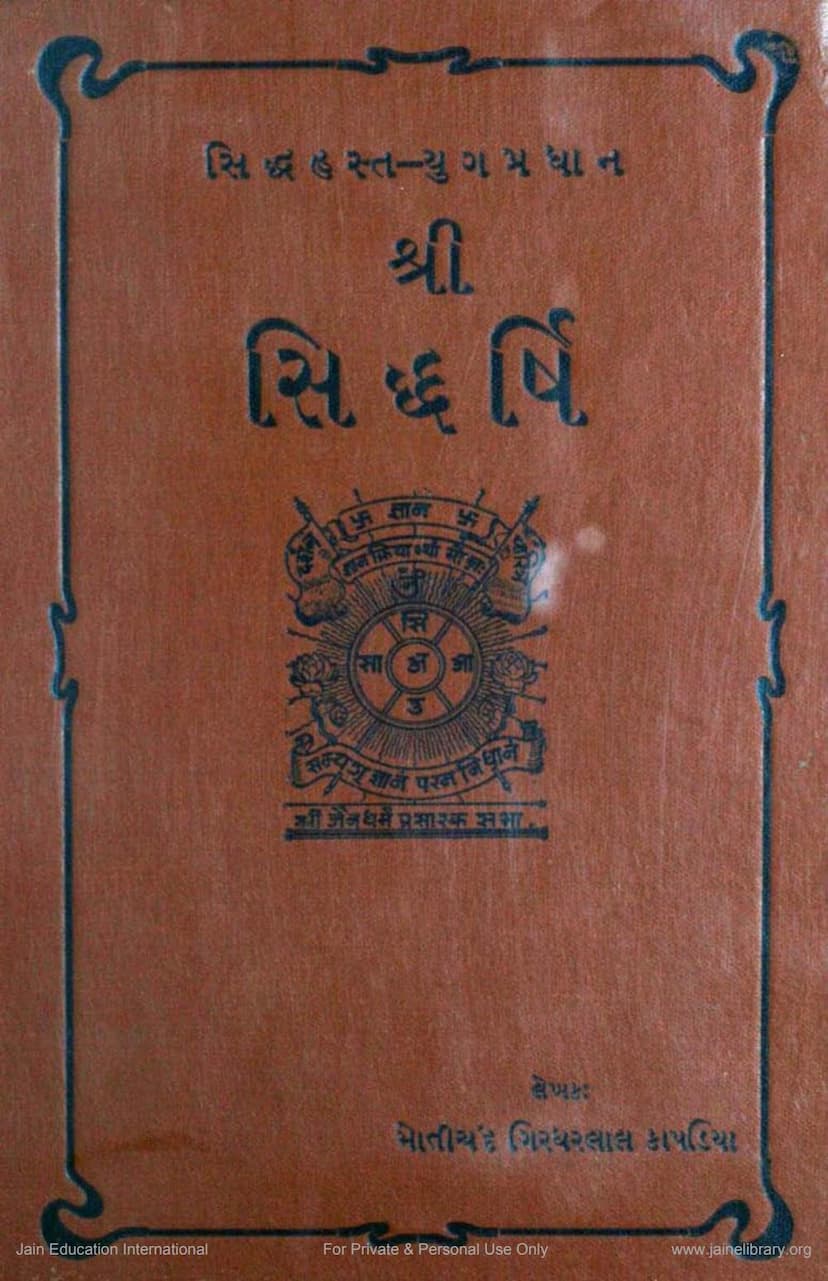Siddharshi
Added to library: September 2, 2025

Summary
This is a comprehensive summary of the Jain text "Siddharshi" authored by Motichand Girdharlal Kapadia and published by Jain Dharm Prasarak Sabha, Bhavnagar. The summary covers various aspects of the book, including its structure, content, and the scholarly efforts behind it, as well as insights into Jain philosophy and literature.
Book Title: Siddharshi Author: Motichand Girdharlal Kapadia Publisher: Jain Dharm Prasarak Sabha, Bhavnagar Publication Year: Veer Samvat 2465 / Vikram Samvat 1995 / 1939 CE
Overview: The book "Siddharshi" is a scholarly exploration and introduction (Upaaghat) to the renowned Jain text "Upamiti Bhava Prapancha Katha" by Acharya Siddharshi Ganini. The author, Motichand Girdharlal Kapadia, has undertaken extensive research to compile the life, times, and works of Acharya Siddharshi, particularly focusing on his magnum opus, the Upamiti Bhava Prapancha Katha. The book is a detailed analysis of this allegorical narrative, its philosophical underpinnings, its literary significance, and the historical context in which it was written.
Key Aspects Covered:
-
The Author's Effort: The book highlights the immense effort and dedication of the author, Motichand Girdharlal Kapadia, in compiling this extensive work. His meticulous research, painstaking compilation of indices, and profound love for the subject matter are evident throughout the text. The publisher, Jain Dharm Prasarak Sabha, is also acknowledged for their support.
-
Introduction to Upamiti Bhava Prapancha Katha:
- The Four Anuyogas: The book explains the four major divisions of Jain scriptures (Dravyanuyoga, Ganitanuyoga, Charan Karananuyoga, and Dharmakathanuyoga) and how Siddharshi masterfully employs them within his narrative.
- Literary Significance: The Upamiti Bhava Prapancha Katha is described as the first extensive and elaborate allegory in Indian literature, predating even the renowned allegorical plays of Indian Sanskrit literature. It is praised for its poetic qualities, its use of metaphors, its grandeur, and its depth in conveying Jain philosophical concepts like Vimala-alokanjan (knowledge), Tattva-pritikar Jal (right perception), and Mahakalyanak Bhojan (right conduct).
- Allegory (Rupak Mahakatha): The text delves into the nature of allegory, explaining how Siddharshi uses symbolic narratives to convey profound spiritual truths. It emphasizes that every word and sentence in the work holds a deeper meaning and purpose.
- The Title: The meaning of "Upamiti Bhava Prapancha" is analyzed, with "Upamiti" referring to analogy or comparison and "Bhava Prapancha" signifying the extensive cycle of worldly existence. The title suggests a narrative that explains the vastness of worldly existence through analogy.
- Structure and Style: The book discusses the narrative structure, the characterizations, the use of vivid imagery, the captivating storytelling techniques, and the author's exceptional command over language and word choice. It highlights the author's ability to blend poetic beauty with profound philosophical insights.
-
Siddharshi's Life and Times:
- Author's Humble Approach: The author, Motichand Girdharlal Kapadia, notes Siddharshi's profound humility, evident in his self-effacing descriptions and his efforts to make the complex teachings accessible to a wider audience.
- Historical Context: The book attempts to place Siddharshi within a historical context, exploring the socio-political and religious conditions of 10th-century India. It mentions the prevalence of various philosophical schools, the role of religion in society, and the impact of historical events on the populace.
- Debates on Siddharshi's Time: The text acknowledges the scholarly debate surrounding Siddharshi's exact time period and his relationship with other prominent figures like Acharya Haribhadra Suri. It presents arguments and counter-arguments based on textual evidence and historical research.
-
Analysis of Content:
- Diverse Subject Matter: The book meticulously details the vast array of subjects covered in the Upamiti Bhava Prapancha Katha, including logic (Nyaya), philosophy (Darshan), Ayurveda, Astrology, Samudrika Shastra (physiognomy), Wit and Humor, Trade, vices, Marriage customs, Military strategy, Politics, Observation, and Psychology.
- Psychological Insights: The text highlights Siddharshi's profound understanding of human nature and his ability to depict various psychological states, inner conflicts, and moral dilemmas through his characters.
- Moral and Spiritual Teachings: The core message of the text is identified as guiding individuals towards spiritual liberation through knowledge, perception, and conduct, emphasizing the principles of non-violence, truthfulness, and detachment.
-
Literary and Linguistic Aspects:
- Language and Style: The book analyzes the Sanskrit language and style employed by Siddharshi, noting its clarity, elegance, and effectiveness in conveying complex ideas. The author's mastery over Sanskrit is highly praised.
- Poetic Qualities: Despite being an allegory, the work is recognized for its poetic beauty, its use of metaphors, and its ability to evoke emotions through descriptions of nature, human relationships, and spiritual experiences. The presence of nine Rasas (emotions) is noted.
- Allegorical Structure: The text discusses the allegorical nature of the work, where characters and events symbolize deeper spiritual truths. The author's skill in weaving these allegories seamlessly into the narrative is emphasized.
-
The Role of Faith and Devotion: The book touches upon the importance of faith and devotion in Jainism, as reflected in the narrative's emphasis on spiritual practices and the pursuit of liberation.
-
Scholarly Apparatus: The book includes extensive indices, appendices, and references, demonstrating the author's rigorous academic approach. The detailed index of places, characters, and allegorical elements is particularly noteworthy.
Overall Significance: "Siddharshi" by Motichand Girdharlal Kapadia is presented as a monumental work that brings to light the genius of Acharya Siddharshi and his timeless allegory, the Upamiti Bhava Prapancha Katha. It serves as an invaluable resource for scholars, students of Jainism, and anyone interested in the rich tapestry of Indian literature, philosophy, and spiritual thought. The book not only illuminates Siddharshi's work but also provides a window into the societal and cultural landscape of ancient India.